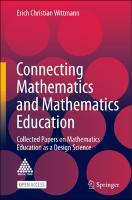Connecting Mathematics and Mathematics Education
Collected Papers on Mathematics Education as a Design Science
| dc.contributor.author | Wittmann, Erich Christian | |
| dc.date.accessioned | 2020-12-14T08:27:56Z | |
| dc.date.available | 2020-12-14T08:27:56Z | |
| dc.date.issued | 2021 | |
| dc.identifier | ONIX_20201214_9783030615703_32 | |
| dc.identifier.uri | https://library.oapen.org/handle/20.500.12657/43294 | |
| dc.description.abstract | This open access book features a selection of articles written by Erich Ch. Wittmann between 1984 to 2019, which shows how the “design science conception” has been continuously developed over a number of decades. The articles not only describe this conception in general terms, but also demonstrate various substantial learning environments that serve as typical examples. In terms of teacher education, the book provides clear information on how to combine (well-understood) mathematics and methods courses to benefit of teachers. The role of mathematics in mathematics education is often explicitly and implicitly reduced to the delivery of subject matter that then has to be selected and made palpable for students using methods imported from psychology, sociology, educational research and related disciplines. While these fields have made significant contributions to mathematics education in recent decades, it cannot be ignored that mathematics itself, if well understood, provides essential knowledge for teaching mathematics beyond the pure delivery of subject matter. For this purpose, mathematics has to be conceived of as an organism that is deeply rooted in elementary operations of the human mind, which can be seamlessly developed to higher and higher levels so that the full richness of problems of various degrees of difficulty, and different means of representation, problem-solving strategies, and forms of proof can be used in ways that are appropriate for the respective level. This view of mathematics is essential for designing learning environments and curricula, for conducting empirical studies on truly mathematical processes and also for implementing the findings of mathematics education in teacher education, where it is crucial to take systemic constraints into account. | |
| dc.language | English | |
| dc.subject.classification | thema EDItEUR::J Society and Social Sciences::JN Education::JNU Teaching of a specific subject | en_US |
| dc.subject.classification | thema EDItEUR::J Society and Social Sciences::JN Education::JNM Higher education, tertiary education::JNMT Teacher training | en_US |
| dc.subject.classification | thema EDItEUR::J Society and Social Sciences::JN Education::JND Educational systems and structures::JNDG Curriculum planning and development | en_US |
| dc.subject.classification | thema EDItEUR::P Mathematics and Science::PB Mathematics | en_US |
| dc.subject.other | Mathematics Education | |
| dc.subject.other | Teaching and Teacher Education | |
| dc.subject.other | Curriculum Studies | |
| dc.subject.other | Mathematics, general | |
| dc.subject.other | Mathematics | |
| dc.subject.other | Relating Mathematics to Mathematics Education | |
| dc.subject.other | Mathematics Education as a Design Science | |
| dc.subject.other | Substantial Learning Environments | |
| dc.subject.other | Integrating Theory and Practice | |
| dc.subject.other | Curriculum Development | |
| dc.subject.other | Developing mathematics education courses | |
| dc.subject.other | Open Access | |
| dc.subject.other | Teaching of a specific subject | |
| dc.subject.other | Teacher training | |
| dc.subject.other | Curriculum planning & development | |
| dc.title | Connecting Mathematics and Mathematics Education | |
| dc.title.alternative | Collected Papers on Mathematics Education as a Design Science | |
| dc.type | book | |
| oapen.identifier.doi | 10.1007/978-3-030-61570-3 | |
| oapen.relation.isPublishedBy | 6c6992af-b843-4f46-859c-f6e9998e40d5 | |
| oapen.imprint | Springer International Publishing | |
| oapen.pages | 318 |

